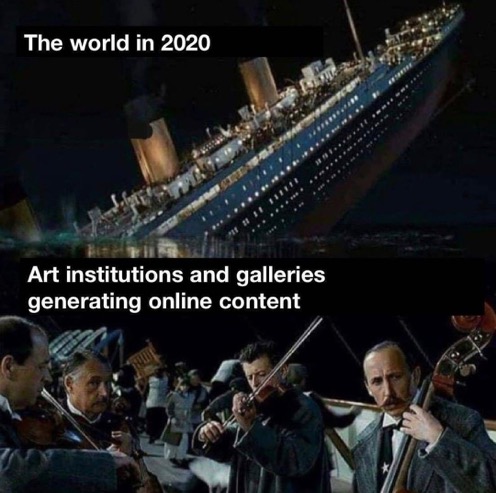
At the website of the curatorial initiative WCSCD (What could/should curating do?), curator Nikita Yingqian Cai asks what museums will look like after the coronavirus pandemic has subsided. They won’t simply revert to their previous state, suggests Cai; the shift towards a smaller-scale, long-distance art experience forced by Covid-19 will persist in some form. Cai argues that this situation presents an opportunity to rethink the practices of blockbuster museums and fair, reconstructing the artworld on a more grassroots basis. Here’s an excerpt from the piece:
During the period of containment, people got used to contactless everything. Contactless payment has prevailed over cash for some time, contactless delivery prevents people from rushing to supermarkets and hoarding, contactless education keeps kids and parents occupied at home… It is not Confucianism or totalitarianism that have stopped Chinese people from going around, it is our easy adaption to contactless socializing. The modernist impulse of abstraction demonstrated by Alfred Barr in Cubism and Abstract Art has been transformed into a powerful, digitized abstraction of capitalism and consumerism. The question is whether the digital intermediary will lead our audience back to the museum after we all recover from the pandemic, or it will completely replace the temporal-spatial intimacy of relating to an artwork in a museum?
One thing we have learnt from the ongoing crisis is the vulnerability of our existing structure of globalization. Individual stories, precarious voices and empirical knowledge can be filtered by ideological constructs and power relations. We are all in this and there is no exclusive position we can take as cultural makers. Identifying ourselves as precariats might smash the forming hierarchy of different social groups, and we have to recognize that labor division between artists (art professionals) and other professions, producers and consumers does not hold a historical legitimacy outside of the Euro-American context. The paradigm of museums and exhibition-making might not be able to accommodate the diverse experiences and document the socioeconomic transformations in the post-corona world. Replicating the model of the modern art museum, reproducing large exhibitions that are anti-ecological, or homogenizing user-consumer experiences of art will not introduce any shift. We have to walk on the ground, resist our impulse of abstraction, indigenize the process of art making and become our own intermediaries to configurate new contacts between people.
Image via WCSCD.